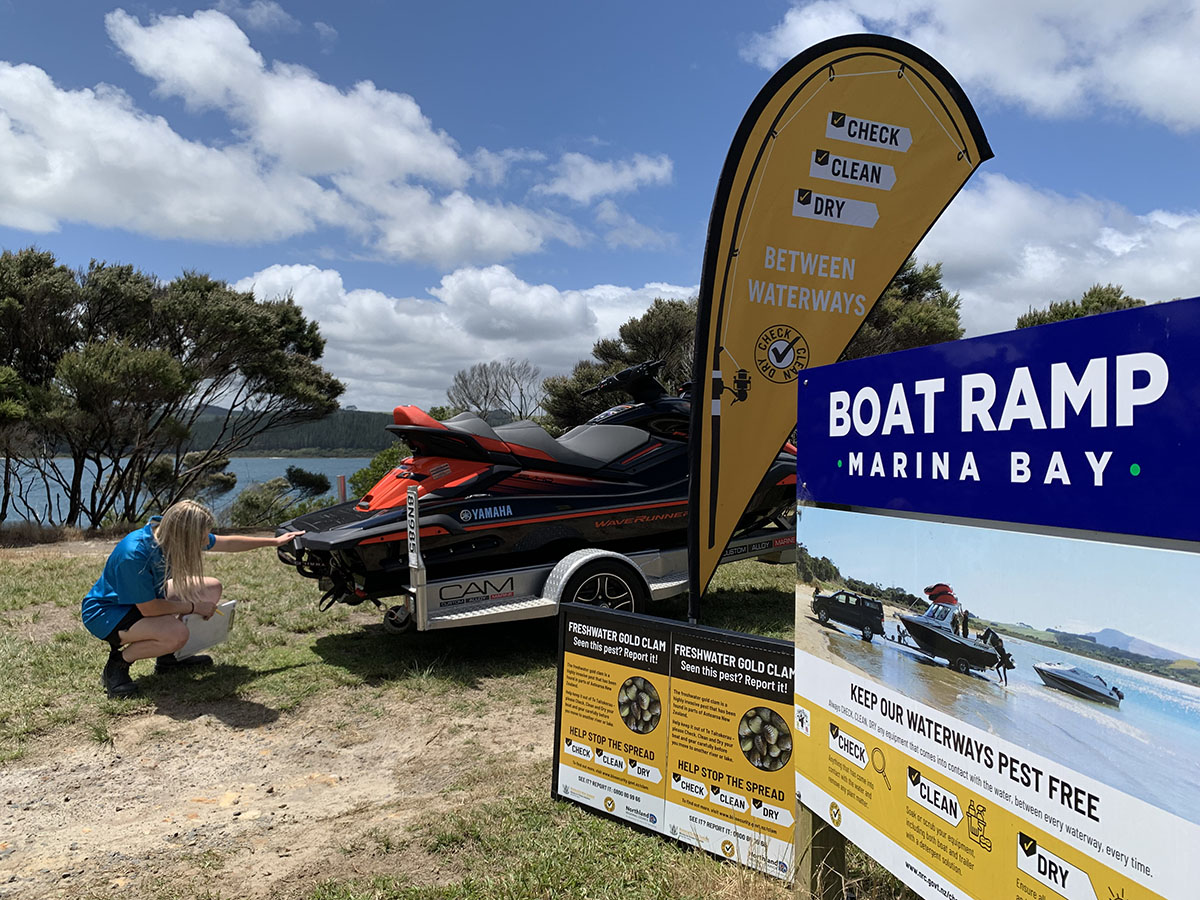Bid to keep invasive clam out of Kai Iwi Lakes
15 Dec 2023, 10:15 AM
Local government and tangata whenua kaitiaki are gearing up to prevent an invasive freshwater clam from reaching and potentially devastating the internationally significant Kai Iwi Lakes.
The Northland Regional Council (which has biosecurity responsibilities) and Kaipara District Council (KDC) (which manages the lakes’ campgrounds and maintains Taharoa Domain) are working with Te Roroa iwi and Te Kuihi hapū to keep gold clam out of the lakes, including popular Lake Taharoa.
Regional council Chair Geoff Crawford says the clam was found in the Waikato River in May this year and has already spread down the river between Lake Maraetai, near Mangakino, and Hamilton City.
A single clam can produce 400 juveniles a day under favourable conditions and has never been eradicated from an invaded location before. The clams are already being reported at a density of hundreds of individuals per square metre in the Waikato, and at highly-infested sites overseas that density can reach up to 20,000 clams per square metre.
Chair Crawford - who also chairs the council’s Biosecurity and Biodiversity Working Party - says normal ‘Check, Clean, Dry’ methods don’t work for gold clam, which can survive for up to 10 days out of water. He says kayaks and boats - especially wake boats with their internal ballast tanks - are the highest risk of spreading the clam.
Kaipara District Mayor Craig Jepson says widespread education is needed to prevent the clam reaching Kai Iwi Lakes, in particular Lake Taharoa, which is much loved by locals and popular with campers and as a summer playground for powered craft.
"The invasive freshwater clam could have significant ecological and economic impacts if it becomes established in the lakes," says Mayor Jepson. "Our team will continue monitoring and education efforts and we look forward to welcoming visitors to Taharoa Domain this summer."
Biosecurity New Zealand’s newly-announced gold clam measures mean that legally, wake boats that have been used on the stretch of Waikato River from the Whakamaru Dam to the river mouth at Port Waikato cannot be used in any other waterways outside that controlled area, including Northland.
Kaipara District Council General Manager, Hayley Worthington, says everyone needs to play their part to protect Kai Iwi Lakes.
"Kai Iwi Lakes are a taonga for locals and visitors," she says. "Up to 2000 people per day enjoy the lakes over the summer months. Visitors all need to follow new ‘Check, Clean, Dry’ procedures before they leave home."
Chair Crawford says the councils and tangata whenua will be carrying out biosecurity checks of boats and gear at the Kai Iwi Lakes between 22 December and 06 February to keep the clams out of the lakes, which are home to the nationally critical lake plant Trithuria inconspicua, which is at high risk of extinction, and the at-risk fish, dune lakes galaxias.
Under KDC’s Taharoa Domain Bylaw 2018 the owner or master of a vessel or power-driven vessel can be denied access to the lakes if they refuse to undertake a biosecurity check if requested.
Chair Crawford says the NRC has allocated $300,000 towards the summer initiative and its staff, as well as KDC and tangata whenua representatives, will be on site to answer any questions people have about gold clam.
Te Roroa General Manager Snow Tane says the lakes are a taonga not just to Northland, but to the national and international communities because of the species they are home to and fully supports NRC action to ensure boat users act responsibly in keeping Lake Taharoa free of this threat.
Similarly, Te Kuihi spokesperson Ric Pārore says the hapū fully supports the biosecurity checks being undertaken at the lakes this summer. "Preventing the spread of invasive species like gold clams upholds the mauri of our lakes and ensures they remain unspoiled for generations to come."
Chair Crawford says humans are the main pathway for biosecurity incursions like gold clam and officials are urging those planning to visit the lakes over summer to ensure they don’t inadvertently bring the clam with them.
He says in a bid to limit the clam’s spread in the Waikato, the Ministry for Primary Industries/Biosecurity New Zealand had already imposed a legal ‘Controlled Area Notice’ (CAN) over most of the Waikato River, from the Whakamaru Dam to the river mouth at Port Waikato.
Under the CAN all wake boats that have been in the controlled stretch of the Waikato River must not be used in any other waterways outside the controlled area.
"This means no wake boats that have been used on this stretch of the Waikato River can be brought to Northland."
Similarly, any other boats or gear used on this stretch of the river must have an updated Check, Clean and Dry process before moving it from the controlled area to another freshwater environment or brackish water.
Chair Crawford says it is hard, if not impossible, to fully empty and dry boat ballast tanks, which means the clam can survive between boating sites.
"Best practice is to use a high-pressure steam cleaner or a power wash on to grass or gravel where there is no likelihood of runoff entering back into a waterway or stormwater system."
"For absorbent materials, such as lifejackets or waders, they must be frozen overnight, or washed with a 10 percent bleach solution, or washed in hot water (45C degrees plus) for 20 minutes."
Further information about gold clams is available from: www.biosecurity.govt.nz

Northland Regional Council Freshwater Advisor - Biosecurity and Biodiversity, Claire Heyns, carries out a biosecurity check on a jetski at Lake Taharoa recently.
